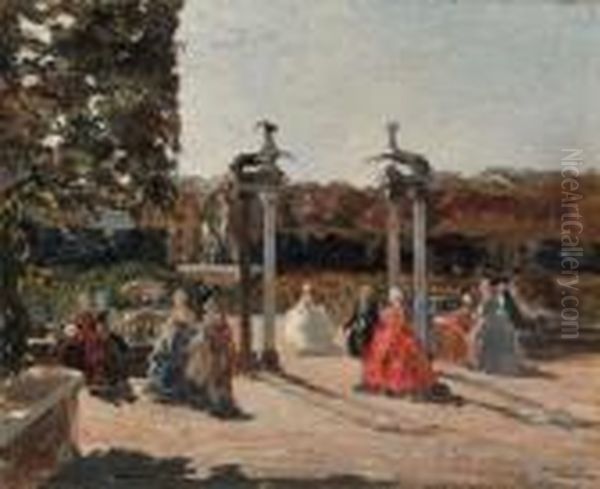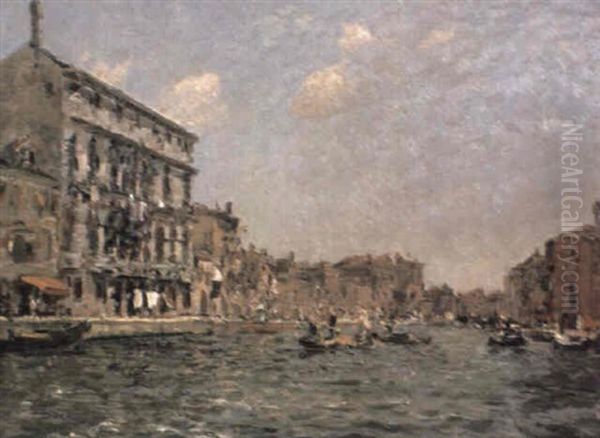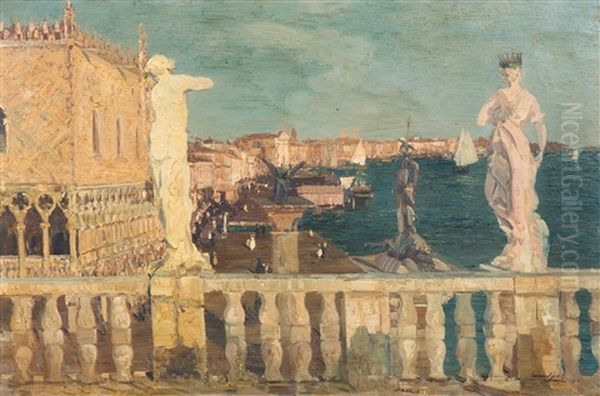
Emma Ciardi stands as a significant figure in early 20th-century Italian art, celebrated for her luminous depictions of Venice and her unique ability to blend the city's rich artistic traditions with modern sensibilities. Born into an artistic dynasty in Venice in 1879, she navigated a path that honored her heritage while establishing her own distinct voice. Her life, spanning from 1879 to her passing in her native city in December 1933, was dedicated to capturing the fleeting beauty and timeless charm of Venice, earning her international acclaim and a lasting place in art history.
As an art historian, examining Emma Ciardi's work involves appreciating the context of her upbringing, the influences she absorbed, and the specific contributions she made, particularly as a successful female artist in a predominantly male field. Her paintings are more than mere representations; they are vibrant interpretations of atmosphere, light, and history, rendered with a distinctive elegance and technical skill.
An Artistic Heritage: The Ciardi Family
Emma Ciardi's immersion in the art world began at birth. Her father, Guglielmo Ciardi (1842–1917), was a leading figure among Venetian landscape painters of his generation, known for his evocative scenes of the lagoon and the Venetian mainland. Guglielmo himself was part of a broader Italian artistic conversation, having spent formative time in Florence, where he befriended key members of the Macchiaioli group, such as Telemaco Signorini. Through Signorini, Guglielmo connected with figures like the critic Diego Martelli, and encountered the work of other masters like Giovanni Fattori and Silvestro Lega, absorbing the principles of painting dal vero (from life).
Guglielmo's experiences extended to Naples, where he engaged with artists like Domenico Morelli and Filippo Palizzi, and encountered the painters of the Scuola di Resina. This rich network of connections and artistic exploration undoubtedly shaped the environment in which Emma grew up. Her brother, Beppe Ciardi (1875–1932), also became a respected painter, continuing the family's artistic legacy alongside Emma. This familial context provided Emma not only with initial training under her father but also with an inherent understanding of the professional art world and its traditions.

The Ciardi household was a crucible of artistic discussion and practice. Emma learned directly from her father, absorbing his sensitivity to light and atmosphere, yet she was never merely an imitator. She built upon this foundation, developing a style that, while rooted in the Venetian tradition her father championed, possessed its own unique character and modern inflections. The Ciardi name carried weight in the Venetian art scene, opening doors but also setting high expectations, which Emma consistently met and exceeded through her talent and dedication.
Forging a Unique Style: Influences and Techniques
Emma Ciardi's artistic style is a fascinating synthesis of tradition and innovation. Deeply influenced by the 18th-century Venetian veduta painters, particularly Canaletto (Giovanni Antonio Canal) and Francesco Guardi, she shared their fascination with the city's architecture, waterways, and festive life. She often revisited their iconic viewpoints but infused them with a distinctly modern sensibility, moving away from precise topographical accuracy towards a more atmospheric and subjective interpretation.
Her engagement with contemporary art movements is evident in her handling of light and color. While not strictly an Impressionist, Ciardi clearly absorbed lessons from French Impressionism, particularly in her vibrant palette, broken brushwork, and keen attention to the effects of natural light on surfaces. There are also affinities with Post-Impressionist techniques, including elements sometimes described as Pointillist, where dabs of color create a shimmering, lively effect, especially in her depictions of water and crowds. Some critics also note an expressive quality in her brushwork, lending an emotional resonance to her scenes.
Ciardi developed a technique characterized by bright, often jewel-like colors and fluid, dynamic brushstrokes. She excelled at capturing the unique luminosity of Venice – the interplay of sunlight on water, the reflections on damp Parian marble, the hazy atmosphere of the lagoon. Her subjects ranged from grand vistas of the Bacino di San Marco or the Grand Canal to more intimate corners, bustling piazzas during Carnival, elegant figures in historical costume evoking the 18th century, and serene garden scenes. This thematic interest in Venice's past, often described as settecentismo, added a layer of nostalgic charm and theatricality to her work.
Representative Works
Emma Ciardi's oeuvre includes numerous paintings that exemplify her style and thematic concerns. While a comprehensive catalogue is vast, several works frequently cited or appearing at auction highlight her artistic range:
Scena Galante (Galant Scene): Often depicting figures in 18th-century attire in garden or palace settings, these works showcase her interest in historical evocation and her delicate, almost Rococo sensibility, updated with modern brushwork. A smaller example, perhaps measuring around 25.5 x 9 cm, demonstrates her ability to create charming vignettes.

Piazza al fazzoletto: This title, possibly referring to a specific location or a type of small, handkerchief-sized square, suggests an intimate urban scene. A work with this title, perhaps around 17 x 25 cm, would likely capture the daily life or architectural charm of a less monumental part of Venice, rendered with her characteristic attention to light.
Carnevale in piazzetta (Carnival in the Small Square): Dated examples like one from 1927 (potentially measuring 76 x 100 cm) capture the vibrant energy of Venetian Carnival. These works often feature masked figures, confetti, and a lively atmosphere, allowing Ciardi to employ a particularly bright palette and dynamic composition.
Beautiful Day (Bel Giorno or Giornata Bella): Titles like this, associated with works such as one from 1931 (perhaps 37.5 x 50 cm), point to her focus on capturing specific atmospheric conditions. These paintings typically emphasize the brilliance of Venetian light on a clear day, reflecting off water and buildings.
Festa al palazzo (Festival at the Palace): Larger compositions, such as one measuring 68 x 110 cm, often depict grand celebrations or gatherings in palatial settings. These works allowed Ciardi to combine architectural rendering with lively figural groups, showcasing her skill in handling complex scenes with rich color and sometimes thicker, more impastoed brushwork to convey texture and opulence.
These examples illustrate Ciardi's recurring themes: the beauty of Venice, its festive traditions, its historical echoes, and the captivating play of light across its unique surfaces. Each work, regardless of size or specific subject, reflects her consistent artistic vision and technical finesse.
On the International Stage: Exhibitions and Recognition
Emma Ciardi achieved significant recognition both within Italy and internationally early in her career. A pivotal moment was her participation in the Exposition Universelle in Paris in 1900. Exhibiting on this prestigious global stage brought her widespread attention and critical acclaim, establishing her reputation beyond Italian borders. This success marked the beginning of a long and fruitful period of exhibition activity.
She became a regular and celebrated participant in the Venice Biennale, one of the most important international contemporary art exhibitions. Her consistent presence there, starting from the early years of the 20th century, solidified her status as a leading Venetian artist. Critics and the public alike admired her ability to present fresh, vibrant perspectives on familiar Venetian themes. Her works were frequently noted for their elegance, technical skill, and appealing subject matter.

Beyond Venice and Paris, Ciardi exhibited extensively throughout Italy, including major shows in Milan, Rome, Florence, Turin, and Genoa. Her international presence continued with exhibitions in London and across the Atlantic. Her work was shown in the United States, including exhibitions noted in cities like Pittsburgh and potentially at venues like the Brooklyn Museum in New York. Records also mention participation in exhibitions in Montreal, Canada, and Panama, indicating a truly global reach for her art during her lifetime. This extensive exhibition history underscores the broad appeal of her work and her active engagement with the international art market and critical discourse of her time.
A Woman's Perspective in a Changing Art World
Emma Ciardi's success is particularly noteworthy when considered within the context of early 20th-century European art, where female artists still faced significant barriers. While benefiting from her family's established position, her sustained career and international recognition were earned through her own talent and perseverance. She carved out a distinct identity, separate from but complementary to her father and brother, becoming arguably the most internationally recognized member of the Ciardi artistic dynasty.
Her work, while focused on the picturesque and historical, can be seen as offering a distinctly female perspective in its sensitivity and elegance. She avoided grand historical or political narratives, preferring to focus on the sensory experience of place, light, and social interaction. Her depictions of elegant social gatherings or serene gardens offer a counterpoint to the more overtly masculine or academic themes prevalent at the time.
Interestingly, despite her professional success and public profile through exhibitions, detailed records of Emma Ciardi's personal life, thoughts, or artistic motivations remain relatively scarce. This lack of extensive documentation lends an air of "mystery" to her biography, leaving her art to speak largely for itself. She appears to have been a relatively private individual, dedicated primarily to her craft. Her focus remained steadfastly on her painting, allowing her to produce a consistent and high-quality body of work throughout her career. Her achievement serves as an important example of a female artist successfully navigating and thriving within the structures of the art world in the early modern period.
Legacy and Enduring Appeal
Emma Ciardi's legacy lies in her masterful synthesis of Venetian artistic tradition with the innovations of modern painting. She revitalized the veduta genre, infusing it with a personal vision characterized by light, color, and atmospheric sensitivity. Her work captured a specific, often idealized, vision of Venice – elegant, picturesque, and bathed in a luminous glow – that resonated deeply with audiences both in Italy and abroad. She stands alongside other Venetian painters of her era, such as Ettore Tito or Mariano Fortuny, who also explored the city's enduring allure, but Ciardi's style remains distinctly her own.
Her paintings continue to be sought after by collectors, regularly appearing at auction houses where they command respectable prices, confirming their lasting appeal in the art market. Works by Emma Ciardi are held in various public and private collections, ensuring her contribution to Italian art history is preserved and accessible. While perhaps less revolutionary than some of her avant-garde contemporaries, her art represents a significant achievement in adapting traditional genres to modern tastes and techniques.
As an art historian, one appreciates Emma Ciardi not only for the aesthetic pleasure her works provide but also for her role as a bridge between centuries and styles. She honored the legacy of Venetian masters like Canaletto, Guardi, and perhaps the genre scenes of Pietro Longhi or the atmospheric skies of Giambattista Tiepolo, while embracing the chromatic freedoms suggested by Impressionists like Claude Monet or Pierre-Auguste Renoir. She remains a testament to the enduring power of Venetian subjects and the possibilities for individual expression within established traditions, securing her place as a significant Italian painter of the early 20th century.